“For the past 10 years, studies have shown that we get less effect from investments. The reasons are an imbalance between long and short term marketing investments driven by an over-use of too narrow personalised digital campaigns that lack creativity."
How do companies measure and follow up their market investment to ensure that it provides value for the business and the brand? The marketing communication industry has lacked a common standard, but the cross-industry Effectiveness Initiative from The Association of Swedish Advertisers, aims to make it easier.
Create emotional effects
“There are several reasons for taking action,” says Hanna Riberdahl, CEO of the Association of Swedish Advertisers. “For the past 10 years, studies have shown that we get less effect from investments. The reasons are an imbalance between long and short term marketing investments driven by an over-use of too narrow personalised digital campaigns that lack creativity. As a result, they fail to create any emotional effects for the brand. And this is one of the most important factors in creating marketing that gives effect.”
What drives the purchasing decision?
The guide covers, among other things; what drives people to make purchasing decisions, the difference between efficiency and effectiveness, and how to achieve the right balance between short- and long-term marketing investments. Its French counterpart, Union des marques, launched the effectiveness system called Le Référentiel in 2020. This was the first platform to measure the effectiveness of communication aimed at brands in Europe. The organisation reached out to members to see which KPIs were being used by marketing departments. They gathered 400 and categorised and prioritised them down to 87 in three categories. The Association of Swedish Advertisers evaluated this further and whittled them down to 36 (24 from UDM and 6 new), in six separate categories.
Go to the Effectiveness system chart
“It’s evident how complex the system is,” Riberdahl says. “There is never a single KPI that will tell the whole truth. Since we work with something as complex as behavioural change, companies have to find the KPIs that are most relevant to the brand and the overall business goals that they are aiming to achieve.”
"Marketing is about influencing behaviour so that people see the value of your brand, to make it selectable and to make consumers want to buy your product or services at a full price"
While brands have trusted data simply describing the ‘what’ in recent years as a result of digitalisation, Riberdahl believes that they also need data that provides the ‘why’. “Marketing is about influencing behaviour so that people see the value of your brand, to make it selectable and to make consumers want to buy your product or services at a full price,” she says. To achieve that, she adds, brands need to evaluate short-term and long-term investments.
Why we are returning to long-term branding
When digital marketing emerged, measurement was focused on finding low-hanging fruit; now brands could use surgery to convert quickly – to reach broadly was a waste. However, when reaching out too narrowly you get the efficiency but not the right lever for effectiveness, Riberdahl points out. “As a result, we are now returning to long-term brand building. There needs to be a balance – it’s not one before the other. You need to do both, with the right balance based on your position, category and goals. Our system helps to measure those goals.”
The text is an excerpt from the article Inspire Creativity written by Jonna Dagliden Hunt, featured in PAPER #4.


